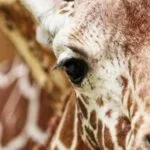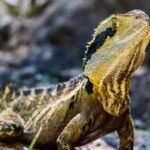Wildlife Sanctuary Welfare – A Q&A with Nicola Field
 Co-founder of international NGO Global Animal Welfare, Nicola (Nic) Field, began her work with captive wildlife more than 20 years ago. She has taken up many specialised posts with wild animals, including that of Bear and Vet Team Director at Animals Asia’s China Bear Rescue Centre, as an animal keeper with North American Black bears, Prezewalski horses, North American bison, big cats and primates, and as a researcher on a range of global conservation projects. To celebrate the news of a collaboration between Wild Welfare and Global Animal Welfare, in our latest blog, we hear from Nic about some of the animal welfare issues affecting wildlife centres and how the two charities are working together to improve animal welfare in wild animal facilities around the world.
Co-founder of international NGO Global Animal Welfare, Nicola (Nic) Field, began her work with captive wildlife more than 20 years ago. She has taken up many specialised posts with wild animals, including that of Bear and Vet Team Director at Animals Asia’s China Bear Rescue Centre, as an animal keeper with North American Black bears, Prezewalski horses, North American bison, big cats and primates, and as a researcher on a range of global conservation projects. To celebrate the news of a collaboration between Wild Welfare and Global Animal Welfare, in our latest blog, we hear from Nic about some of the animal welfare issues affecting wildlife centres and how the two charities are working together to improve animal welfare in wild animal facilities around the world.
Thank you, Nicola for joining us in this Question & Answer session! Firstly…
How did Global Animal Welfare get started and what were some of the main reasons for establishing the charity?
I met fellow co-founder Annemarie Weegenaar while working for Animals Asia, where we both worked for more than a decade at the bear sanctuaries in China and Vietnam. We were in similar roles and for a large amount of time we both held the position of Bear and Vet Team Director, myself in China, Annemarie in Vietnam, where we oversaw the veterinary and bear care teams. During our years in Asia we travelled a lot. We had the opportunity to visit many wildlife rescue centres and sanctuaries in Asia and around the world.
It was clear that many facilities have the best intentions, however, they face immense challenges which have led to animal welfare being compromised.
Five years ago, during a trip to Bali, we discussed what the future held after leaving Animals Asia, and how our work had enthused our passion for animal welfare. Having identified the challenges faced by many sanctuaries and rescue centres, we considered how we could apply our experience and knowledge to make a difference – and so Global Animal Welfare was born.
What are some of the most common animal welfare issues you see in your work and how is the charity helping tackle these?
Many sanctuaries and rescue centres are operating on limited resources which can be really challenging when they are constantly striving to provide the best possible care for the animals and improve animal welfare. For example, some facilities provide essential refuge for wild animals but lack even the most basic needs like water and electricity. Often staff in sanctuaries and rescue centres in many parts of the world have not had the opportunity to benefit from the many resources and study opportunities that exist in developed countries, in order to learn and develop their animal care skills and provide optimal welfare.
Relevant resources are often in another language or simply not available and limited knowledge on animal behaviour affects the welfare of animals under their care.
Furthermore, there is a gap in knowledge on health and safety, which is a real concern as many sanctuaries and rescue centres house potentially dangerous animals. Global Animal Welfare is working to address these gaps, through continuous training and monitoring, enabling facilities to grow the best care and welfare expertise to care for their animals.
Are wildlife centres and sanctuaries under pressure to take wild animals in when they don’t have capacity, and what effect can this have on individual animals and overall animal welfare?
Simply – yes! Often these facilities are expected and sometimes forced to take confiscated animals. This may be at the request of government bodies, for example in situations where wildlife is caught up in trade. Arguably the ‘rescued’ animals are better off in a sanctuary or rescue centre, however, if space is limited, resources are stretched and expertise is stretched, then animal welfare will be compromised. Overall, animal welfare can be affected in many ways; by inappropriate groupings of animals, over-populated animal enclosures, inadequate or insufficient food, the lack of or inappropriate environmental enrichment, poor husbandry and a poor caregiver-animal relationship. Many zoos and aquariums around the world face the same issue with wild animals – either confiscated or injured – coming into them, just as sanctuaries do, with lack of resources, capacity and potential reduction in animal welfare standards as a result.
That is why the partnership between Global Animal Welfare and Wild Welfare is so important.
Zoos and aquariums sometimes receive negative press for animal welfare issues, but it’s less common to hear about welfare issues within a sanctuary or rescue centre, is there is a reason for this?
I think the reason for this is implied by the terminology that is used when referring to the different types of facilities housing wildlife around the world. Sanctuary or rescue centre evokes the idea of a place of animal refuge, a place where displaced wildlife can find a compassionate alternative to their former lives, places that provide lifetime care, where animals can be safe and well.
There is also a disassociation between sanctuary and captivity, because in reality the animals in a sanctuary or rescue centre are still in captivity, but many people who may be against ‘captivity’ and against zoos for example, choose to support sanctuaries and rescue centres.
Furthermore, sanctuaries and rescue centres may not come under the same scrutiny as zoos and aquariums as they are not open to the public or only have a limited number of visitors, so public insight into the set-up of a facility and their work is somewhat controlled.
What do you think is the most serious welfare concern affecting captive wild animals at the moment and is it the same throughout the world?
Resources and appropriate care. Limited resources and inappropriate care compromises animal welfare in a range of facilities around the world. Global Animal Welfare is tackling this, by running bespoke workshops and working with animal care staff in wildlife sanctuaries and rescue centres. Training topics covered depend on a wildlife facility’s requirements and can include animal welfare concepts, behavioural-based husbandry, animal nutrition, environmental enrichment, health assessments and health and safety to name a few.
What simple steps can everyone take that will help improve conditions for those wild animals living in captive facilities around the world that may be suffering poor welfare?
People can do a bit of homework before visiting or supporting any facility housing captive wildlife. Make sure the facility is one that operates ethically and with integrity, Global Federation of Animal Sanctuaries (GFAS), can provide useful information regarding accredited sanctuaries. There are lots of credible facilities and they deserve all the support they can be provided with, at the same time, there are some facilities operating as sanctuaries and rescue centres only really in the name ‘sanctuary’, and their actual set up is purely as a tourist attraction. And if people encounter facilities that are genuine, but are struggling to meet the needs of their animals, then contacting organisations like Global Animal Welfare can be the first step to enabling us to support these facilities and their wildlife.
To learn more about Global Animal Welfare, visit their website HERE
The views, opinions and positions expressed by guest bloggers are theirs alone, and do not necessarily reflect the opinions of Wild Welfare or any employee thereof. Wild Welfare is not responsible for the accuracy of any of the information supplied by the guest bloggers. We accept no liability for any errors, omissions or representations. The copyright of this content belongs to the author and any liability with regards to infringement of intellectual property rights remains with them.
Image © Global Animal Welfare: Nic working in a captive facility with a polar bear





